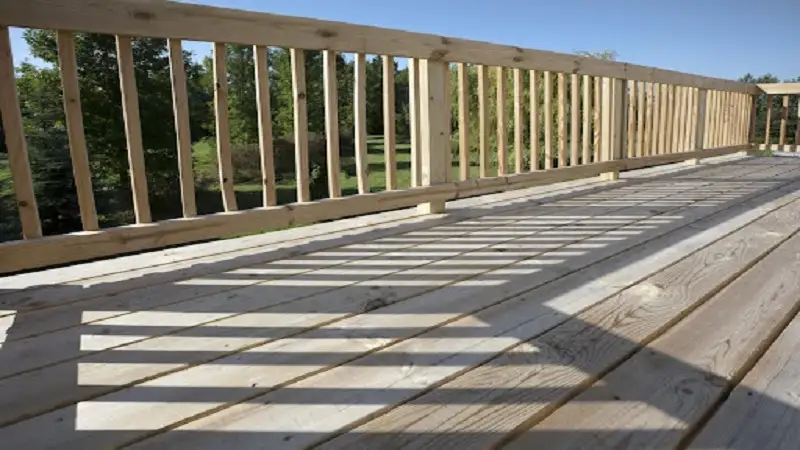Installing deck railings is a critical part of increasing the usefulness and attractiveness of your outdoor space. Wooden railings are the most economical alternative but demand higher maintenance. Vinyl and composite railings allow for a low-maintenance option with cost efficiencies from moderate to high. Metal railings (aluminum and steel) offer durability along with a more modern, appealing appearance for a contemporary deck. Glass railings are more costly but offer zero obstructions and elegance, if that is what you’re looking for.
Table of Contents
- Deck Railing Types and Cost
- Installation Cost Factors
- Comparison Table: Material, Costs, and Features
You step out on your newly renovated deck, coffee in hand, ready to take in the fresh morning air, but something is missing – the railings. Whether you’re building a new deck or upgrading to a better modern deck railing, when it comes to deck railings, it’s all about figuring out which railing systems are valuable and outstanding, as you want to create a space that is useful and provides eye-appeal.
Deck railings come in different materials, each with its own cost range, benefits, and disadvantages. From traditional wooden designs to contemporary metal options, your options may feel a little overwhelming, but we aim to simplify them for you. We will detail all the information you will need on deck railing installation costs and help you determine which will provide you with the best options for your needs. For example, many homeowners seek a modern look but also want durability. They will find that metal railing for deck solutions strikes the perfect balance between elegance and practicality.
In this guide, we will explain the types of railings, what influences costs, and how to help you make the best choice of railings for your deck. You will leave with all the knowledge to make a good decision.
Types of Deck Railings and Their Costs
There are probably many types of deck railings that a homeowner needs or wants, too many combinations of material and preferences to list. Each material offers its own •Again, the higher the cost the longer it will last, and the more aesthetic beauty it offers. So we will look at some common examples of types of deck railings, how much they cost, and the positives and negatives.
Wooden Railings
Wooden railings are a timeless choice, offering a warm and natural look that blends seamlessly with outdoor spaces. Typically crafted from cedar, pine, or pressure-treated lumber, they provide flexibility in design and customization.
- Cost Range: Cost: $15–$40 per linear foot (includes material and installation)
- Wooden railings are relatively inexpensive compared to other types.
Wooden railings can take many shapes, designs, and decorative aspects; if you want to paint or stain your railing, you just need to be aware that it may affect your warranty, upkeep, or wood itself.
Vinyl Railings
Vinyl railings are growing in popularity for their simple elegance and low maintenance. Made of solid PVC, vinyl railings are resistant to fading, weathering, and moisture – great for the Canadian climate.
- Price Range: $20 – $45 per linear foot (includes materials and installation)
- Pros: Affordable maintenance, does not rust or rot, many colors and styles available, very limited customization available, easily cracks when impacted
- Cons: very limited customization and can crack with heavy impacts
Vinyl is a great option for homeowners looking for something weather-resistant, and believe it or not, it won’t break the bank. For contemporary decks, vinyl railings are the perfect choice with sleek and clean lines.
Composite Railings
Composite railings offer some of the beauty of wood while keeping the durability of synthetic materials.
- Cost Range: $30-$60 per linear ft (material and labor).
- Pros: Extremely low maintenance, resistant to moisture and insects, and available in a range of finishes.
- Cons: Higher initial cost compared to wood or vinyl.
Composite Railings are a great option for homeowners looking for something weather-resistant, and believe it or not, it won’t break the bank. For contemporary decks, composite railings are the perfect choice with sleek and clean lines.
Metal Railings (Aluminum and Steel)
Metal railings are a whole new level of modern luxury, offering a clean, modern look and durability that’s unmatched.
- Cost Range: $35-$75 per linear ft (material and labor).
- Pros: low maintenance, long-lasting, and finally, they can be found in many finishes and styles.
- Cons: Higher price point up front, and steel can require extra structural support.
Metal railings appeal to homeowners wanting a contemporary, polished styling. Metal can withstand harsh weather conditions and is a great choice for Canada’s changing climate.
Glass Railings
For those who prioritize unobstructed views and a touch of luxury, glass railings are an excellent option. These railings use tempered or laminated glass panels supported by metal frames, creating a seamless and sophisticated look.
- Cost Range: $50–$100 per linear foot (material and installation).
- Pros: Expensive, must continually be cleaned by a professional, fingerprints or water spots are visible.
- Cons: Expensive, must continually be cleaned by a professional, fingerprints or water spots are visible.
Glass railings are ideal for low decks that offer great views, such as a lake or a mountain.
Factors Affecting Installation Costs
1. Labor Costs
Labour is the largest part of your installation costs. Normally skilled contractors will charge $10 to $30 for their labour, depending on their geography or market location. Weekend warriors, DIY, tend to defer their costs to skilled, polished contractors that get the job done quicker, safer, and won’t have to deconstruct any issues. If you are in an urban area, especially Toronto or Vancouver, labour costs will generally be higher due to the skill set and pricing of the market. If you have a curvy deck design, more angles, or a multi-roof design, this can increase the labour55 rate.
2. Design Complexity
If you have custom or fancy details, this could drastically increase your material costs and your labour to install. Examples include fancy balusters, decorative posts, and built-in lights, which are all time-sensitive projects since they require a detail most homeowners would never invest their time.
3. Local Climate Conditions
This variation in climate throughout Canada indicates that there may be some materials and designs that work better in some geographic areas than in others. For example, if we are speaking about decks or other railings for a coastline residence, corrosion-resistant metal railings may be the preferred option, especially with the high salt levels in the air. Also, if we are speaking about residences in a cold climate, the material may have to withstand cycles of freeze-thaw, breaking and deforming in the process. All of these would affect other elements of materials, installation, and cost.
4. Additional Features
Costs can also rise with upgrades such as built-in LED lights, powder-coated paint, and custom painting. These features may create somewhat of a purpose and visual addition, but they will come with extra materials and labour. For instance, if the work is using very high-powered solar post caps with LED lights, this could add an extra 20-50 dollars per cap. The powder coating of all metal railings just to get them to match a custom-painted job could cost 5-10 dollars per linear foot.
5. Permits and Building Codes
You might require permits before installing deck railings so that it become compliant with the building codes of a particular area. In Canada, the majority of municipalities specify railing of decks over 24 inches (60 cm) off the ground. Non-compliance with these regulations may lead to the imposition of penalties or compulsory demolition of structures that are non-compliant. The cost of permitting also depends on the area, but normally the cost of a permit is between 50$ to 200$.
6. Existing Deck Conditions
When your deck is old or poorly made, you might need to make new repairs or reinforcements prior to new railings. As an example, replacing your rotted deck boards or strengthening your support posts can cost hundreds or even thousands of dollars to your project. It is always prudent to hire a professional to check your deck to detect any problems.
Comparison Table: Material Costs and Features
To make it easier to compare the different railing options, we’ve compiled a detailed table outlining the costs, maintenance requirements, durability, and aesthetic appeal of each material. This at-a-glance reference will help you weigh the pros and cons of each choice based on your priorities – whether it’s budget, longevity, or style.
| Material | Cost per Linear Foot | Maintenance | Durability | Aesthetic Appeal |
| Wood | $15–$40 | High | Moderate | Traditional/Rustic |
| Vinyl | $20–$45 | Low | High | Clean/Simple |
| Composite | $30–$60 | Very Low | Very High | Modern/Elegant |
| Metal (Aluminum) | $35–$75 | Very Low | Very High | Sleek/Contemporary |
| Glass | $50–$100 | Moderate (Cleaning) | High | Modern/Luxurious |
Final Thoughts
The selection of the best deck railing is not just a matter of taste or preference but rather a decision that will have implications on your safety, property value, and enjoyment of outdoor living as well. So much material, style, and pricing to take into consideration, so it is good to approach it smartly. Whether you like the classic appearance of wood, want to have a maintenance-free vinyl or composite, or prefer the contemporary look of metal and glass, you can find the one that will fit your homeowner needs.
Finally, the most appropriate railing for your deck will be a balance between the form and the functionality, and it will represent your own sense of style, but also serve your practical needs. Think over the situation, seek the help of experts where necessary, and select a solution that can improve your outdoor area in safety and aesthetics.
A well-thought-out deck railing can be more than an afterthought to your home; it can be a part of your home in which your memories are made and your moments treasured. See more

